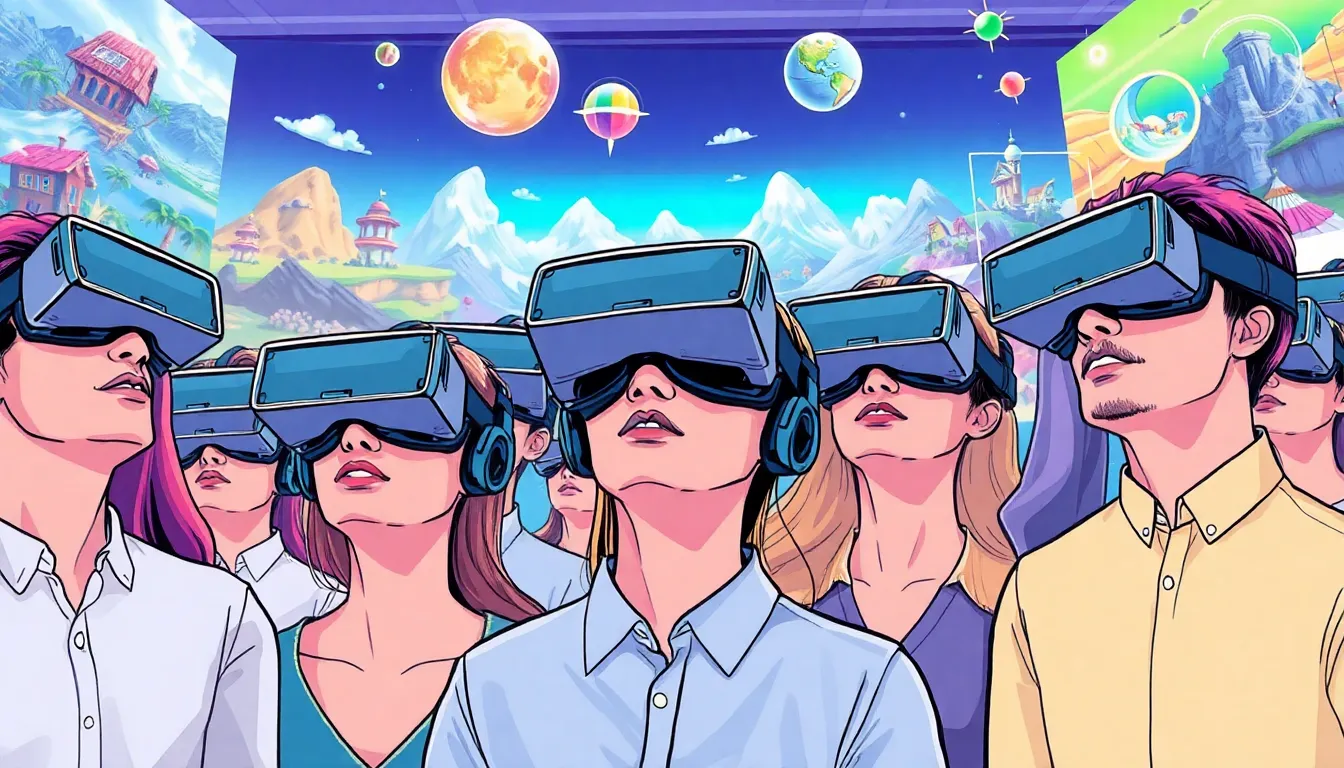Imagine slipping on a headset and instantly being transported to a world where dragons roam free and the coffee never goes cold. Virtual reality software is revolutionizing how people experience entertainment, education, and even remote work. It’s not just a flashy gimmick; it’s a game-changer that’s making the impossible feel possible.
Table of Contents
ToggleOverview Of Virtual Reality Software
Virtual reality software creates immersive environments that users can interact with. These applications cater to various industries, including gaming, education, training, and healthcare. In gaming, VR software delivers an engaging experience, allowing players to step inside their favorite worlds.
Education benefits significantly from virtual reality applications, offering interactive learning experiences. Students explore historical sites or conduct virtual science experiments, making learning more engaging. VR also streamlines training processes for professionals, offering realistic simulations for hands-on experiences, particularly in medical and aviation sectors.
Key components in virtual reality software include rendering engines and motion tracking systems. Rendering engines present high-quality graphics, ensuring realism. Motion tracking systems capture user movements, allowing for seamless interactions within the virtual environment.
Some popular virtual reality software options include Oculus SDK, Unity, and Unreal Engine. Oculus SDK specializes in VR gaming and app development. Unity offers a versatile platform for creating both 2D and 3D experiences, while Unreal Engine excels in producing stunning visuals for high-end applications.
Businesses increasingly adopt virtual reality software for collaborative workspaces. Remote teams use VR to meet in virtual offices, enhancing communication and collaboration. These advancements transform how individuals connect, regardless of geographical barriers.
Furthermore, the market for virtual reality technology is rapidly expanding. According to Statista, the market size reached $15.81 billion in 2020 and is projected to grow to $57.55 billion by 2027. Investing in VR software presents numerous opportunities for companies to innovate and stay competitive in their fields.
Key Features Of Virtual Reality Software

Virtual reality software delivers unique features that create powerful experiences across various fields. It allows users to engage in simulations that replicate real-world environments and tasks.
Immersive Experiences
Immersive experiences engage users in a way that traditional media cannot. Virtual reality transports them to different realities through detailed graphics and interactive elements. Users explore vast virtual worlds or engage in complex scenarios that mimic real-life situations. Enhanced sensory feedback, including sound and haptic feedback, adds to the immersion. Users adapt their actions based on what they experience, creating a deeper connection with the environment. This level of engagement is crucial in sectors like education and training, allowing for risk-free practice and exploration that traditional methods may not provide.
User Interface Design
User interface design in virtual reality software prioritizes intuitiveness and accessibility. Effective UI enables seamless navigation within a three-dimensional space. Elements such as hand gestures or voice commands facilitate interaction without obstructing the immersive experience. Developers focus on creating menus and interfaces that users can easily understand while minimizing distractions. Feedback from users plays a significant role in refining these designs, ensuring comfort and usability. Engaging layouts encourage exploration, making the experience enjoyable while maintaining functionality.
Popular Virtual Reality Software Options
Various virtual reality software options cater to different needs across industries. These tools enable users to engage in immersive experiences, enhancing interactivity and productivity.
Software For Gaming
VR gaming software includes platforms like Oculus SDK and Unity. These tools allow developers to create captivating virtual worlds. Oculus SDK provides seamless integration with hardware, enhancing user experiences. Unity’s flexibility supports multiple genres, from action to simulation, attracting diverse gamers. Engaging environments and stunning graphics elevate gameplay, making players feel as if they’re truly inside the game. Additionally, VR gaming often features multi-user capabilities, enhancing social interaction among players.
Software For Education
Educational VR software transforms learning experiences. Platforms like Engage and Labster offer immersive simulations for students. Engage allows users to conduct virtual classes within 3D environments, promoting active participation. Labster specializes in science lab simulations, enabling learners to conduct experiments without real-world risks. These tools deepen understanding by providing interactive visuals and experiential learning opportunities. Educators find that students retain information better through these engaging formats, highlighting the effectiveness of VR in education.
Software For Business Applications
In the business realm, VR software enhances collaboration and training. Tools like Spatial and vSpatial create virtual meeting spaces for remote teams. Spatial encourages immersive teamwork, allowing colleagues to share ideas in 3D environments. vSpatial combines productivity tools with a VR workspace, optimizing workflows. Training simulations in areas like healthcare and aviation prepare employees for real-world scenarios. Businesses benefit from reduced costs and increased efficiency through these innovative applications, paving the way for a more connected workforce.
Benefits Of Using Virtual Reality Software
Virtual reality software brings numerous advantages across various sectors, driving innovation and enhancing user experiences.
Enhanced User Engagement
Involvement in virtual reality captivates users in ways traditional media can’t. Users can interact with digital environments, leading to higher retention rates and deeper emotional connections. VR’s immersive nature allows individuals to fully engage their senses, making activities feel real and significant. The multi-user capabilities enable shared experiences, fostering social interaction among participants. Companies employing VR often report increased motivation and satisfaction from users, resulting in improved performance metrics. Overall, enhanced engagement translates to more compelling experiences, whether in gaming, training, or educational contexts.
Innovative Learning Opportunities
Virtual reality software revolutionizes learning environments. Students experience virtual field trips and active participation in simulations, which enhances knowledge retention. Educational institutions leverage VR to provide real-world scenarios, enabling learners to practice skills in a risk-free setting. Programs such as Labster and Engage offer rich interactive content, aligning with diverse learning styles. These innovative approaches to education not only facilitate deeper understanding but also inspire curiosity and exploration. VR empowers learners to connect theoretical knowledge to practical applications, thereby transforming the educational landscape.
Challenges In Virtual Reality Software
Virtual reality software faces several challenges that hinder its widespread adoption and development.
Technical Limitations
Technical limitations significantly impact virtual reality experiences. Frame rates often need optimization to prevent motion sickness, and high latency can disrupt user immersion. Hardware configurations present compatibility issues across devices, creating inconsistent user experiences. Graphics rendering demands require powerful GPUs, which may not be accessible to all users. Additionally, insufficient motion tracking accuracy can lead to disorientation, detracting from the overall experience. These factors combine to challenge developers as they strive to enhance user engagement and satisfaction.
Cost Constraints
Cost constraints also pose a barrier for both consumers and developers. High-quality VR hardware, like headsets and motion sensors, tends to have steep price points, limiting accessibility for casual users. Development expenses for creating sophisticated VR software can soar due to specialized skill requirements and extensive testing. Small businesses may struggle to justify investment in VR technology despite its potential benefits. Budget limitations often restrict the scope of projects, hindering innovation in the field. Thus, financial considerations play a critical role in shaping the future of virtual reality software.
Virtual reality software is reshaping how individuals engage with various aspects of life. Its ability to create immersive experiences has revolutionized entertainment education and training. As industries continue to explore VR’s potential the benefits become increasingly clear. Enhanced user engagement improved learning outcomes and streamlined processes are just the beginning.
Despite the challenges facing VR technology including high costs and technical limitations the future looks promising. With market growth on the horizon innovation is set to flourish. As developers overcome existing barriers the transformative power of VR will likely become more accessible to a broader audience. Embracing this technology could lead to exciting advancements across multiple sectors making it a vital area to watch.




